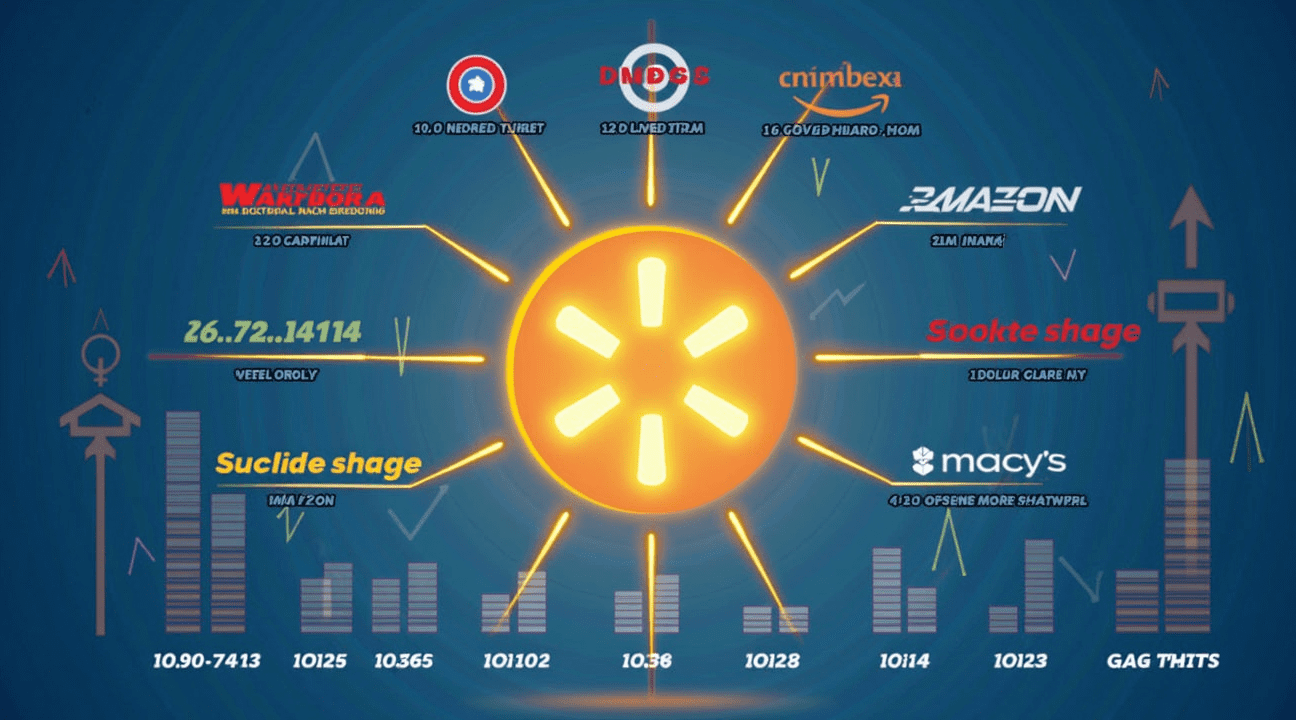Walmart completed its first stock split in 25 years on February 26, 2024, executing a 3-for-1 split that gave shareholders three shares for every share they previously owned.
This significant corporate action ended the retail giant’s quarter-century break from stock splits and underlined a renewed commitment to making shares more accessible to individual investors. By executing this move, Walmart acknowledges major changes in the investing landscape, including the rise of zero-commission trading platforms and increased participation from retail investors influenced by social media and other digital platforms.
Key Takeaways
- Walmart’s 2024 3-for-1 stock split marked the company’s first in 25 years, ending a pattern that began after their last split in 1999.
- The split transforms an original 1970 IPO share into 1,536 shares through 12 total splits, showcasing one of the most aggressive splitting strategies among major retailers.
- Walmart’s split decision reflects evolving market trends, including higher individual investor participation driven by commission-free platforms and market visibility via social media.
- Compared to its competitors, Walmart has engaged in more splits, surpassing Target (5 splits), Amazon (4 splits), and Costco (2 splits), highlighting its unique approach to share accessibility.
- Stock splits are mechanical in nature—they don’t create real value but can significantly enhance share liquidity and make shares more affordable for smaller investors.
Learn More
For more insight into Walmart’s financial history and current strategies, visit Walmart’s official corporate site.
Walmart Executes First Stock Split in 25 Years with Historic 3-for-1 Move
Walmart made headlines on February 26, 2024, when it executed its first stock split in over two decades. This 3-for-1 stock split provided shareholders with three shares for every single share they previously held in their portfolios.
The timing of this corporate action carries significant weight in Walmart’s history. I’ve observed that the company’s last split occurred in 1999, creating a remarkable 25-year gap between these two major events. This extended period without any splits represents one of the longest stretches among major retail corporations, suggesting a fundamental change in how Walmart views stock accessibility and share price management.
Strategic Timing and Market Impact
The February 2024 split demonstrates Walmart’s renewed commitment to making its shares more accessible to retail investors. Before the split, WMT shares had climbed to levels that potentially created barriers for smaller investors looking to purchase whole shares. The 3-for-1 action immediately tripled the number of outstanding shares while proportionally reducing the per-share price.
Following the split execution, Walmart’s stock price adjusted accordingly to reflect the increased share count. The company’s shares closed at $94.40 on July 10, 2025, showing how the stock has performed in the months following this significant corporate event. This price level demonstrates the stock’s continued appeal to investors across different segments of the market.
Breaking the 25-Year Pattern
The decision to end this quarter-century hiatus from stock splits signals several strategic considerations. Companies typically avoid splits when management believes the higher share price conveys prestige or when they want to maintain a certain shareholder profile. However, Walmart’s move suggests a shift in philosophy that prioritizes broader ownership accessibility.
This Walmart stock split aligns with broader market trends where major corporations are reconsidering the benefits of lower nominal share prices. The retail giant joins other large-cap companies that have recently pursued similar strategies to enhance liquidity and attract diverse investor participation.
The 3-for-1 ratio proves particularly noteworthy because it creates a more substantial reduction in share price compared to traditional 2-for-1 splits. This approach indicates Walmart’s confidence in its stock’s long-term prospects while simultaneously making shares more attainable for average investors who prefer purchasing round lots rather than fractional shares.
Stock splits don’t change the fundamental value of an investment, but they can influence trading dynamics and investor psychology. The increased liquidity resulting from more shares trading at lower prices often benefits both institutional and retail investors through tighter bid-ask spreads and enhanced market efficiency.
Walmart’s decision also reflects broader equity market trends where accessibility and democratization of investing have become central themes. The split supports the company’s efforts to maintain relevance among younger investors who increasingly participate in equity markets through commission-free trading platforms.
The recent split positions Walmart to potentially attract new shareholders who previously viewed the stock as too expensive for their investment budgets. This expanded shareholder base could provide additional support for the stock’s valuation while increasing overall market participation in WMT shares.
Looking at the post-split price performance, the stock’s behavior suggests that investors have responded positively to this corporate action. The current trading levels indicate that the split achieved its intended purpose of creating a more accessible entry point without negatively impacting the stock’s fundamental appeal or institutional interest.

How One IPO Share Became 1,536 Shares Through Walmart’s Aggressive Split Strategy
Few companies demonstrate the power of stock splits quite like Walmart, which has transformed a single IPO share into an impressive 1,536 shares through systematic splitting over five decades. I find this cumulative effect particularly striking when examining how consistent split strategy can compound shareholder value over time.
The Mathematics Behind Walmart’s Split History
Walmart’s split history begins with its 1970 IPO, when shares traded at $16.50 each. Since then, the retail giant has executed 12 stock splits, creating an extraordinary 1,536-fold increase in share count for original investors. The company completed 11 two-for-one splits before implementing its most recent 3-for-1 split in 2024.
This aggressive approach to splitting demonstrates how companies can maintain share accessibility while preserving value for long-term investors. Each split effectively doubled shareholders’ holdings in the earlier instances, while the 2024 split tripled the share count. The mathematical progression shows 2 raised to the 11th power, then multiplied by 3, yielding the current 1,536 multiple.
Strategic Timing During High-Growth Periods
Walmart’s most aggressive splitting occurred during its explosive growth phase in the 1980s and 1990s, when the company averaged one split every 2.3 years. This period coincided with the retailer’s rapid geographic expansion and the establishment of its discount retail dominance across America.
The timing wasn’t coincidental. Management recognized that keeping share prices accessible encouraged broader retail investor participation, which supported trading liquidity and market interest. During these decades, global equity markets were experiencing significant growth, and Walmart positioned itself to benefit from increased investor appetite for growth stocks.
The IPO price of $16.50 per share, when adjusted for all subsequent splits, represents an incredibly small fraction of today’s trading price. This split-adjusted return demonstrates how patient investors who held through multiple business cycles and splits could build substantial wealth. The company’s decision to pursue frequent splits during its highest-growth periods helped ensure that shares remained within reach of average investors, supporting the stock’s long-term appreciation trajectory.
Recent activity, including the 2024 3-for-1 split, suggests Walmart continues viewing stock splits as a valuable tool for maintaining investor accessibility while rewarding long-term shareholders through increased share ownership.
https://www.youtube.com/watch?v=rwWrc1MO-OM
Why Walmart Stopped Splitting for 25 Years and What Changed Their Mind
Walmart’s 25-year hiatus from stock splits between 1999 and 2024 represents one of the most significant strategic shifts in corporate finance communication. During this extended period, I witnessed fundamental changes in how retail giants approached shareholder relations and market accessibility.
The Great Pause: Understanding Walmart’s Split Moratorium
The company’s decision to halt stock splits stemmed from dramatic changes in investor demographics and market structure. Retail investor participation plummeted from 62% to just 28% during this period, while institutional ownership surged to 72%. This shift fundamentally altered Walmart’s approach to share price management.
Management recognized that institutional investors – pension funds, mutual funds, and hedge funds – don’t experience the same psychological barriers to high share prices that individual retail investors often face. These sophisticated investors focus primarily on global equity markets performance metrics rather than absolute share price levels.
Fractional share trading emerged as another game-changing factor. Brokerage platforms began offering retail investors the ability to purchase portions of expensive stocks, effectively eliminating the traditional accessibility argument for stock splits. This technological advancement reduced pressure on companies to maintain artificially low share prices through frequent splitting.
Strategic Priorities During the Split Freeze
Instead of pursuing stock splits, Walmart’s leadership channeled resources into what they viewed as more meaningful financial strategies. Stock buybacks became the preferred method for returning value to shareholders, as these programs actually reduce the total number of outstanding shares and can boost earnings per share (EPS).
The company’s financial team emphasized several key advantages of this approach:
- Share repurchases demonstrate management’s confidence in the company’s intrinsic value
- Buybacks can provide tax advantages compared to dividend distributions
- Reducing share count creates mathematical improvement in per-share metrics
- Strategic timing of repurchases allows management to capitalize on market volatility
Walmart’s executives consistently communicated that stock splits don’t create actual value – they simply divide existing value among more shares. This mathematical reality led them to prioritize earnings growth and operational efficiency over cosmetic share price adjustments.
Management also recognized that frequent splits can send mixed signals to the market. Some investors interpret splits as admission that stock prices have become “too high,” potentially creating unintended psychological pressure on future appreciation.
The company’s strategic communication during this period focused heavily on fundamental business metrics. Revenue growth, margin expansion, and market share gains became the primary narratives, rather than share price accessibility concerns.
The 2024 Strategic Reversal
Walmart’s decision to resume stock splits in 2024 reflects evolving market conditions and strategic priorities. The Walmart stock split by 3-for-1 marked a significant shift in the company’s investor relations strategy.
Several factors likely influenced this reversal. Retail investor participation experienced a resurgence through social media-driven interest in stock markets and commission-free trading platforms. Additionally, the company may have recognized that lower share prices could enhance options liquidity and trading volume.
The timing also coincided with Walmart’s efforts to rebrand itself as a technology-forward retailer rather than just a traditional big-box store. Stock splits often generate positive media attention and can signal management’s optimism about future growth prospects.
Market psychology continues to play a role in investor behavior, despite the logical arguments against it. What the 3-for-1 stock split means for investors extends beyond mere mathematical adjustments to encompass broader strategic messaging.
The 2024 split decision suggests Walmart’s leadership now views stock accessibility as complementary to, rather than competitive with, other value creation strategies. This balanced approach acknowledges both institutional investor sophistication and retail investor psychology in crafting comprehensive shareholder communication strategies.
https://www.youtube.com/watch?v=nkUzICDPYtw
Walmart Dominates Retail Peers with Most Aggressive Split History
I’ve examined the stock split patterns across major retail companies, and Walmart’s track record stands out remarkably from its competitors. The retail giant has executed 12 stock splits throughout its corporate history, creating a cumulative 1,536-fold increase in share count that dwarfs every other major retailer.
How Walmart’s Split Activity Compares to Major Retail Competitors
When analyzing key trends developing in global equity markets, Walmart’s aggressive splitting strategy becomes even more apparent. Target, often considered Walmart’s closest competitor, has completed only 5 splits with a cumulative x48 effect on share count. This represents just a fraction of Walmart’s splitting activity, despite Target’s own significant growth trajectory over decades.
Amazon presents an interesting contrast with 4 splits generating a x240 cumulative impact. While Amazon’s technology-driven business model has produced explosive growth, the company hasn’t matched Walmart’s frequency of splits. Costco’s warehouse membership model has generated substantial returns for shareholders, yet the company has implemented just 2 splits with a modest x4 cumulative effect.
Several major retailers have taken even more conservative approaches to stock splits:
- Dollar General – Has never executed a stock split, despite its expansion across rural America.
- Macy’s – Has completed only one split in recent decades, resulting in a x2 cumulative impact.
These patterns highlight how Walmart’s stock split strategy differs significantly from industry peers.
The frequency of Walmart’s splits reflects the company’s historical commitment to maintaining share price accessibility for retail investors. During Walmart’s most aggressive growth phases, particularly through the 1980s and 1990s, the company regularly split shares as prices climbed. This strategy helped ensure that individual investors could continue purchasing whole shares without requiring substantial capital outlays.
Recent retail market dynamics have shifted, with many companies moving away from frequent splits. However, Walmart’s 3-for-1 stock split approach demonstrates the company’s continued belief in share price management as a tool for investor accessibility.
The contrast between Walmart and its peers illustrates different philosophies regarding optimal share prices and investor accessibility. While some retailers have allowed share prices to appreciate without intervention, Walmart has consistently chosen to reset its trading range through splits, maintaining its position as the retail sector’s most active splitting company.

Common Investor Mistakes When Interpreting Stock Splits
Stock splits create significant confusion among both new and experienced investors. I’ve observed many traders making costly errors by misreading the true meaning behind these corporate actions. Understanding these common pitfalls can prevent financial missteps and lead to better investment decisions.
Overvaluing Stock Splits as Performance Indicators
The biggest mistake investors make involves treating stock splits as automatic buy signals. Split announcements often generate excitement, but this enthusiasm frequently overlooks critical factors. I notice many traders assume that Walmart’s recent 3-for-1 stock split guarantees future price appreciation, when splits are purely mechanical adjustments.
Companies execute splits to improve share liquidity and accessibility, not to create instant value. The underlying business fundamentals remain unchanged immediately after a split occurs. Revenue, profit margins, debt levels, and competitive positioning stay identical. Smart investors focus on these core metrics rather than getting caught up in split excitement.
Market psychology plays a role in post-split performance, but it’s temporary and unreliable. Some stocks experience short-term momentum following splits, while others decline despite positive split news. External factors like interest rates, inflation, consumer spending patterns, and industry trends carry far more weight in determining long-term stock performance.
Ignoring Modern Corporate Strategy Alternatives
Today’s management teams employ sophisticated approaches to enhance shareholder value beyond traditional stock splits. Contemporary strategies emphasize several key areas:
- Share buyback programs that reduce outstanding shares and boost earnings per share
- Dividend increases that provide direct cash returns to shareholders
- Strategic acquisitions that expand market reach and revenue streams
- Operational efficiency improvements that increase profit margins
- Technology investments that strengthen competitive advantages
Companies like Walmart demonstrate how stock splits work alongside these broader corporate initiatives. Management combines splits with ongoing buyback programs and dividend policies to create multiple value drivers simultaneously. This comprehensive approach delivers more sustainable returns than splits alone.
EPS growth through operational improvements carries far more significance than cosmetic changes to share count. I recommend analyzing how companies achieve earnings growth – whether through revenue expansion, cost reduction, margin improvement, or share count reduction through buybacks. These factors create genuine value creation rather than accounting adjustments.
Successful investors also monitor how management communicates about splits within their overall capital allocation strategy. Companies that present splits as part of broader shareholder-friendly policies typically demonstrate stronger long-term commitment to value creation. Those that oversell split benefits without substance often disappoint investors over time.
Market conditions significantly impact how splits perform regardless of company quality. During bull markets, splits may generate positive momentum as investors chase growth opportunities. Bear markets or economic uncertainty can suppress split-related enthusiasm as investors prioritize safety over speculation.
I’ve seen investors make the mistake of timing split announcements without considering broader market trends or economic cycles. Successful investing requires balancing company-specific events like splits with macroeconomic analysis and sector performance.
The most profitable approach involves treating splits as neutral events that may provide tactical opportunities within a broader investment thesis. Focus on whether the underlying business deserves investment based on competitive position, financial health, and growth prospects. Use splits as potential entry points when combined with attractive valuations, but never as standalone investment rationales.
Research shows that companies announcing splits often have strong recent performance, which may have already been priced into the stock. This means the split announcement itself provides limited additional upside potential. Smart investors look for splits in quality companies trading at reasonable valuations rather than chasing momentum following split news.
How Split-Adjusted Prices Work and What They Mean for Returns
Stock splits create a mathematical adjustment that maintains investor value while changing the fundamental structure of share ownership. When Walmart executes a 3-for-1 split, each existing share worth $300 transforms into three shares priced at $100 each. This proportional reduction ensures that shareholders experience no immediate gain or loss from the split itself.
The mechanics work precisely because the total market capitalization remains constant during a split event. If I own 100 shares at $300 each before the split, my investment value equals $30,000. After the 3-for-1 split, I hold 300 shares at $100 each, maintaining that same $30,000 value. The split doesn’t create wealth – it redistributes the same ownership across more shares at a lower per-share price.
Understanding Split-Adjusted Price Data
Split-adjusted stock price calculations reveal Walmart’s extraordinary growth trajectory since its initial public offering. Historical price charts that show split-adjusted data provide a cleaner picture of actual investment returns by normalizing all price movements across multiple split events. Without these adjustments, price charts would show dramatic drops at each split date, creating misleading visual representations of the stock’s performance.
Split-adjusted prices work backward from current prices to show what historical prices would have been if all subsequent splits had already occurred. For example, if Walmart trades at $160 today and has undergone multiple 2-for-1 splits since a particular historical date, the split-adjusted price for that date would reflect the cumulative impact of all those splits. This methodology allows investors to calculate accurate long-term returns without manually accounting for each split event.
The Walmart stock split history demonstrates how split adjustments preserve the integrity of return calculations. When I analyze decades of Walmart’s performance, split-adjusted data shows the true appreciation of the underlying business value rather than artificial price discontinuities caused by corporate actions.
Price adjustment mechanics also affect dividend calculations in split-adjusted analysis:
- Dividends per share decrease proportionally with each split
- Total dividend income remains unchanged for existing shareholders
For instance, a $3 dividend on one share becomes a $1 dividend on three shares after a 3-for-1 split, maintaining the same total payment while adjusting the per-share amount.
These adjustments prove essential for technical analysis and trend identification. Moving averages, support and resistance levels, and other technical indicators require consistent price data to function properly. Split-adjusted prices ensure that technical patterns remain meaningful across split events, preventing false breakouts or support failures that result from corporate actions rather than market forces.
Long-term returns calculations benefit significantly from split-adjusted methodology. Without proper adjustments, computing compound annual growth rates or total returns over extended periods becomes complex and error-prone. Split-adjusted data streamlines these calculations by presenting a continuous price series that reflects actual investment performance.
The recent Walmart split exemplifies how these adjustments maintain analytical continuity. Investors can compare current valuations directly with historical levels using split-adjusted prices, enabling meaningful assessments of whether the stock appears expensive or attractive relative to its trading history.
Split-adjusted analysis also helps identify the real impact of business fundamentals on stock performance. Revenue growth, earnings expansion, and market share gains drive genuine appreciation in split-adjusted prices. This clarity helps separate legitimate business success from the cosmetic effects of stock splits, providing better insight into management effectiveness and competitive positioning.
Understanding these price adjustments enhances portfolio management decisions. Investors can:
- Set realistic return expectations based on historical split-adjusted performance
- Evaluate position sizing more accurately
- Compare Walmart’s returns with other investments on an equal footing
The broader equity market trends become more apparent when viewed through properly adjusted price data that eliminates split-related distortions.

Sources:
MLQ.ai: “Walmart (WMT) Stock Splits”
Pocket Option: “WMT Stock Split History”: 5 Critical Mistakes Costing Investors
Cheddar Flow: “Walmart Stock Split: History, Impact, and What Investors Should Know”
Companies Market Cap: “Stock split history for Walmart (WMT)”
Investing.com: “Walmart (WMT) Stock Split History”
Walmart Investor Relations: “Stock Split History :: Walmart Inc. (WMT)”
Asymmetric Investing/YouTube: “Walmart’s 3-for-1 Stock Split: Everything You Need to Know”
MacroTrends: “Walmart – 53 Year Stock Price History | WMT”


